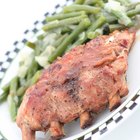Mallivan/iStock/GettyImages
A bone-in smoked ham is fully cooked at the time of purchase, so it's safe and ready to eat without cooking or doing anything else to it. While you can eat it cold, you may want to warm it in the oven as part of a hot meal. The bone helps keep the meat moist, and it adds some flair to the meal's presentation; the main downside is slightly more involved carving. Add your own personal touch by glazing the ham with a homemade sweet or tangy sauce.
Position your oven racks so you can heat the ham in approximately the center of the oven. Preheat it to 325 degrees Fahrenheit, allowing about 20 minutes for the oven to rise to this temperature.
Line a baking pan with aluminum foil and apply a light coating of nonstick spray or cooking oil to prevent sticking. Place the ham on the baking pan and put it into the middle of the oven.
Create a glaze for the ham, if you want. You can make a glaze by putting about 2 cups of pineapple juice, orange juice, apple cider, cola or balsamic vinegar in a small saucepan over medium-high heat and bringing it to a boil, then reducing the heat to medium-low; alternatively, heat honey or maple syrup over medium-low heat. Stir in complementary seasonings, such as brown sugar, molasses, a citrus fruit zest, garlic, ginger, soy sauce, Dijon mustard or cayenne pepper. Reduce until the glaze reaches the desired consistency.
Bake the ham for the length of time called for based on the weight; in general, expect a whole bone-in smoked ham to take about 18 minutes per pound. Hams on the bone cook a bit faster than boneless cuts, since the bone becomes quite hot and radiates heat from the middle. When there's about 20 minutes left, take the ham out of the oven and brush the glaze over the entire surface, then return it to the oven. Don't apply it earlier, or you risk it burning.
Measure the internal temperature of the ham with a meat thermometer. Press it into the center of the ham, but don't let the stem make contact with the bone, or it throws off the reading. Remove the ham when it reaches 140 F. Carve and serve it right away; there's no need to rest smoked ham.
Related Articles

Cooking Instructions for a Ridge Creek ...
Tips on How to Cook a Spiral Ham

How Do I Roast a Picnic Ham?
Crock-Pot Ham and Bean Soup Recipe

How to Smoke a Ham Shank on a Charcoal ...

How to Heat Pre-Cooked Hams

How to Roast a Split Turkey

How Do I Cook a Smoked Gammon Joint?

How to Create a Foil Tent for Cooking ...

How to Cook Turkey Legs on the Grill

The Best Way to Cook a Shank Half Ham

The Best Way to Prepare Bison Sirloin

How to Slow-Cook Meat in the Oven

How to Fully Cook a Hickory Smoked Ham

How to Cook Prime Rib Using an Oven ...

Reheating a BBQ Pork Shoulder

How to BBQ Ribs on a Smoker

How to Cook a Filipino Ham
How to Cook a Spencer Roast

How to Bake a Pork Loin Center Half
References
Resources
Tips
- To carve a bone-in ham, shave a slice or two from the bottom to create a level base. Beginning at the smaller end, make vertical cuts down to the bone; how far apart you make the cuts determines the thickness of your servings. Then, cut horizontally along the top of the bone to sever the slices from the ham. Cut slices as you need them, as leftovers won't dry out as much if they're still on the bone.
Writer Bio
Eric Mohrman is a food and drink, travel, and lifestyle writer living in Orlando, Florida. He has professional experience to complement his love of cooking and eating, having worked for 10 years both front- and back-of-house in casual and fine dining restaurants. He has written print and web pieces on food and drink topics for Visit Florida, Orlando Style Magazine, CrushBrew Magazine, Agent Magazine, Dollar Stretcher Magazine, The 863 Magazine and other publications.